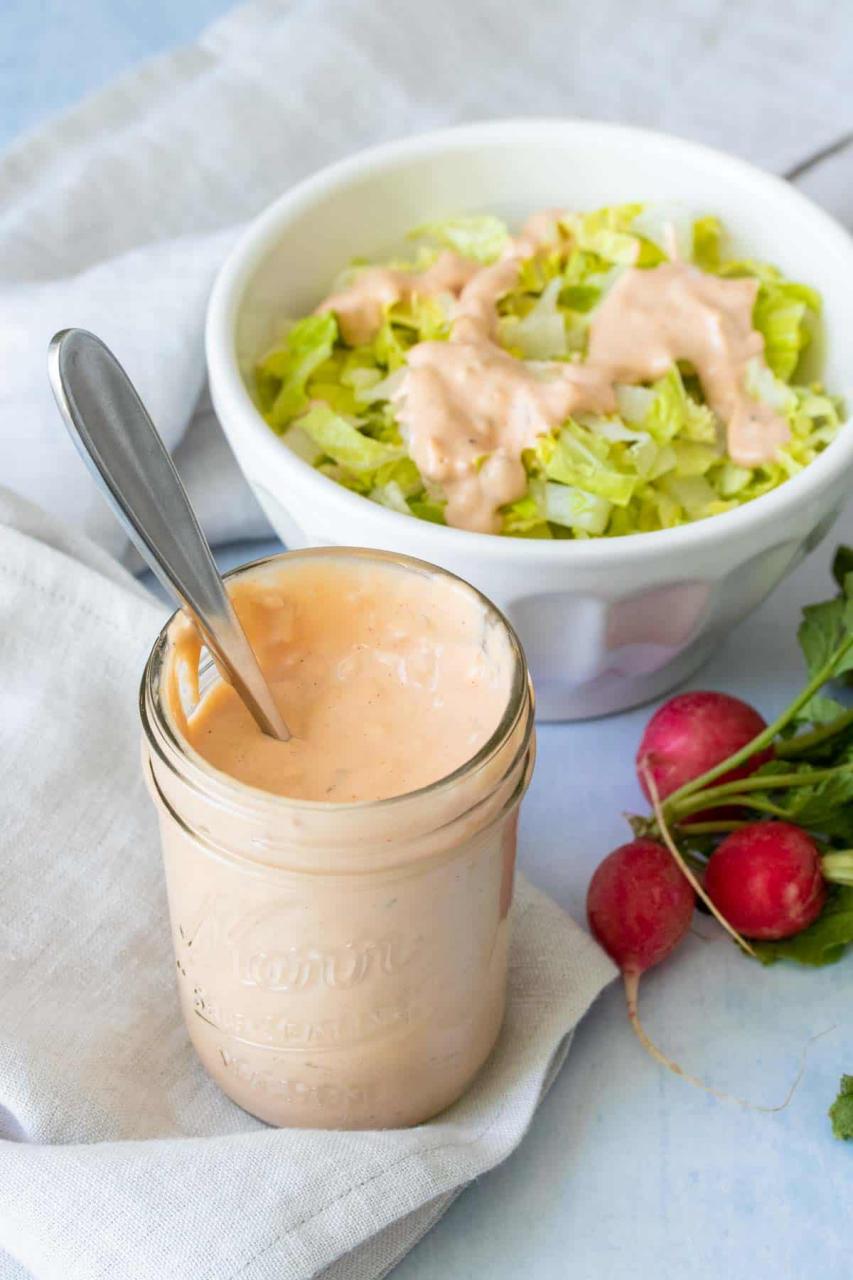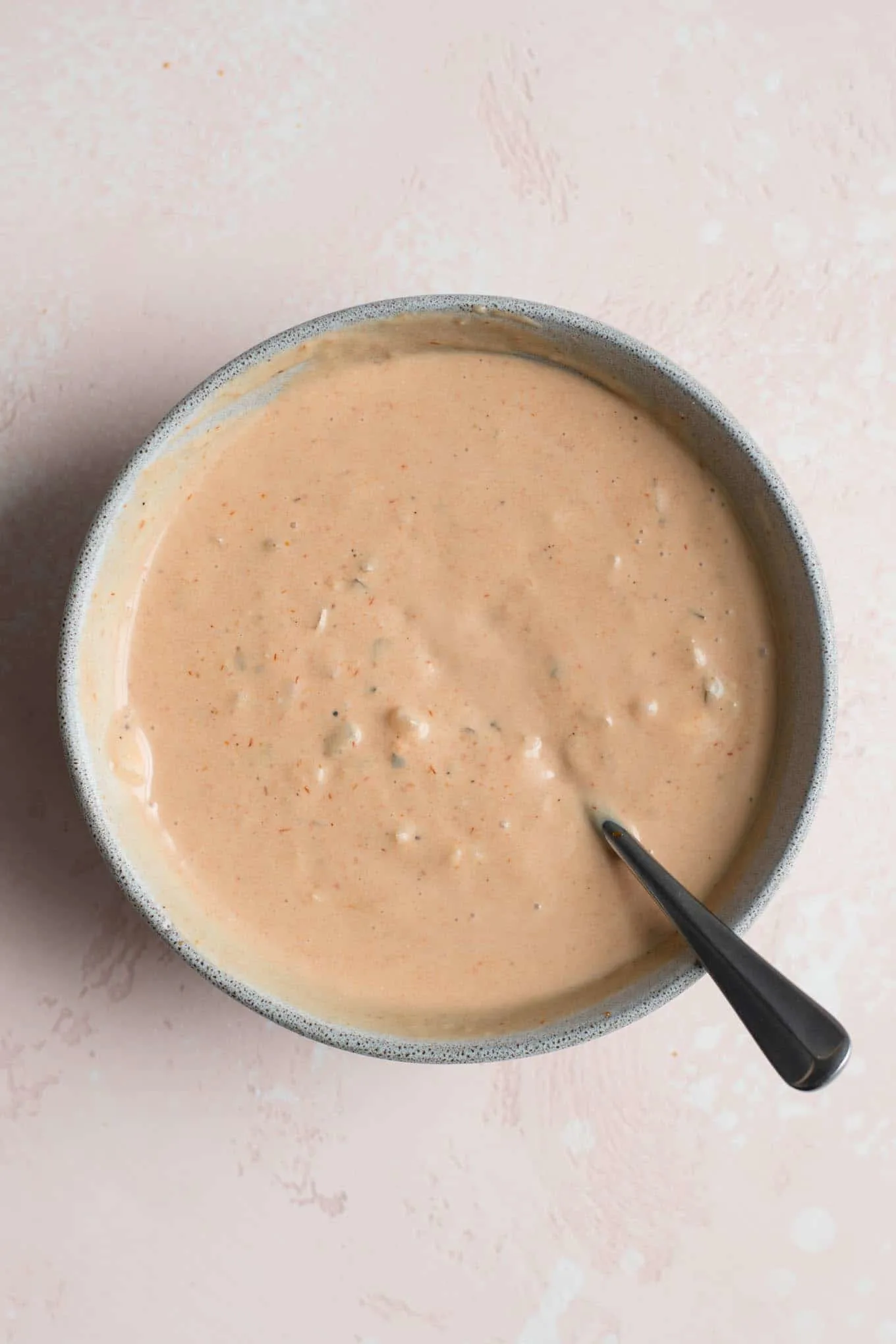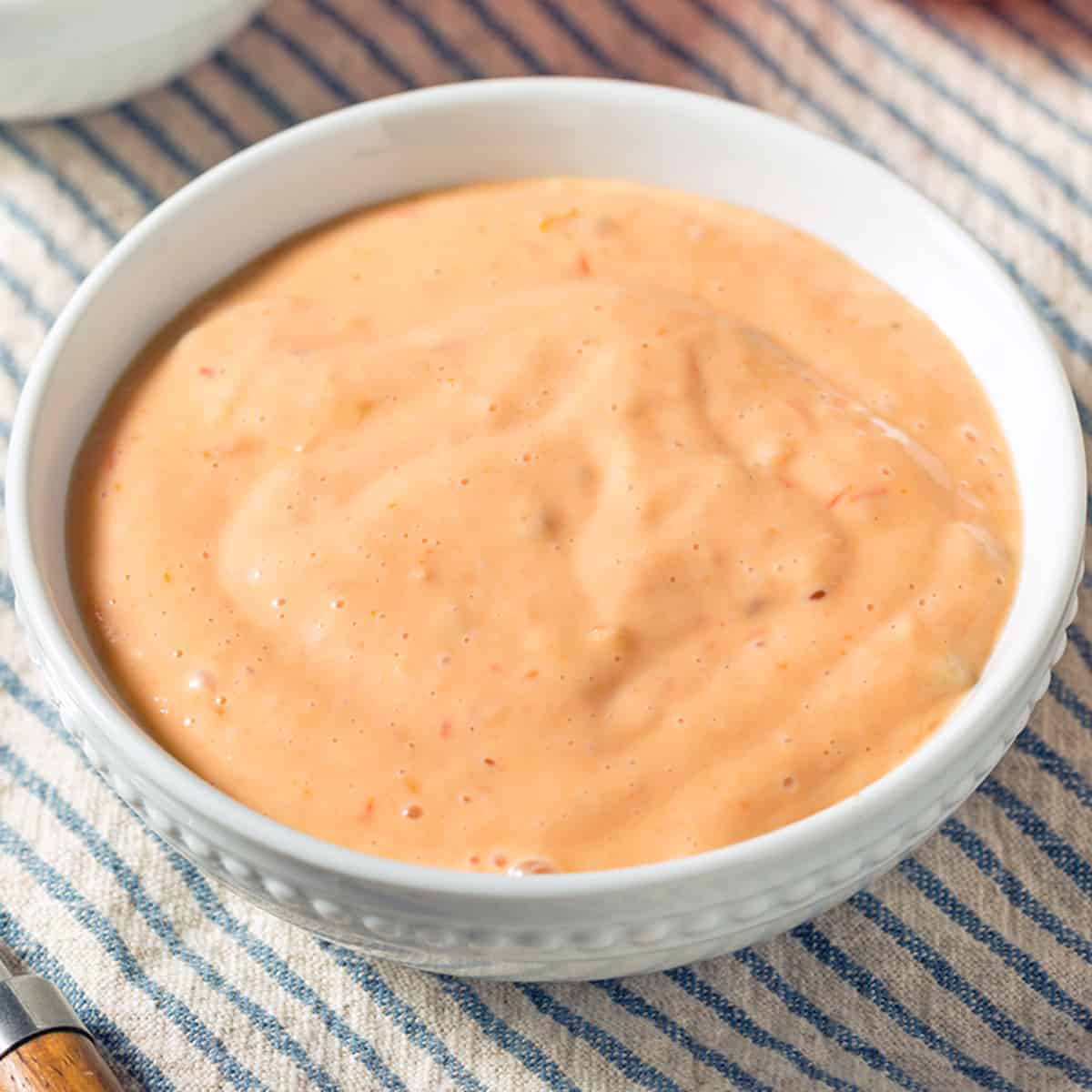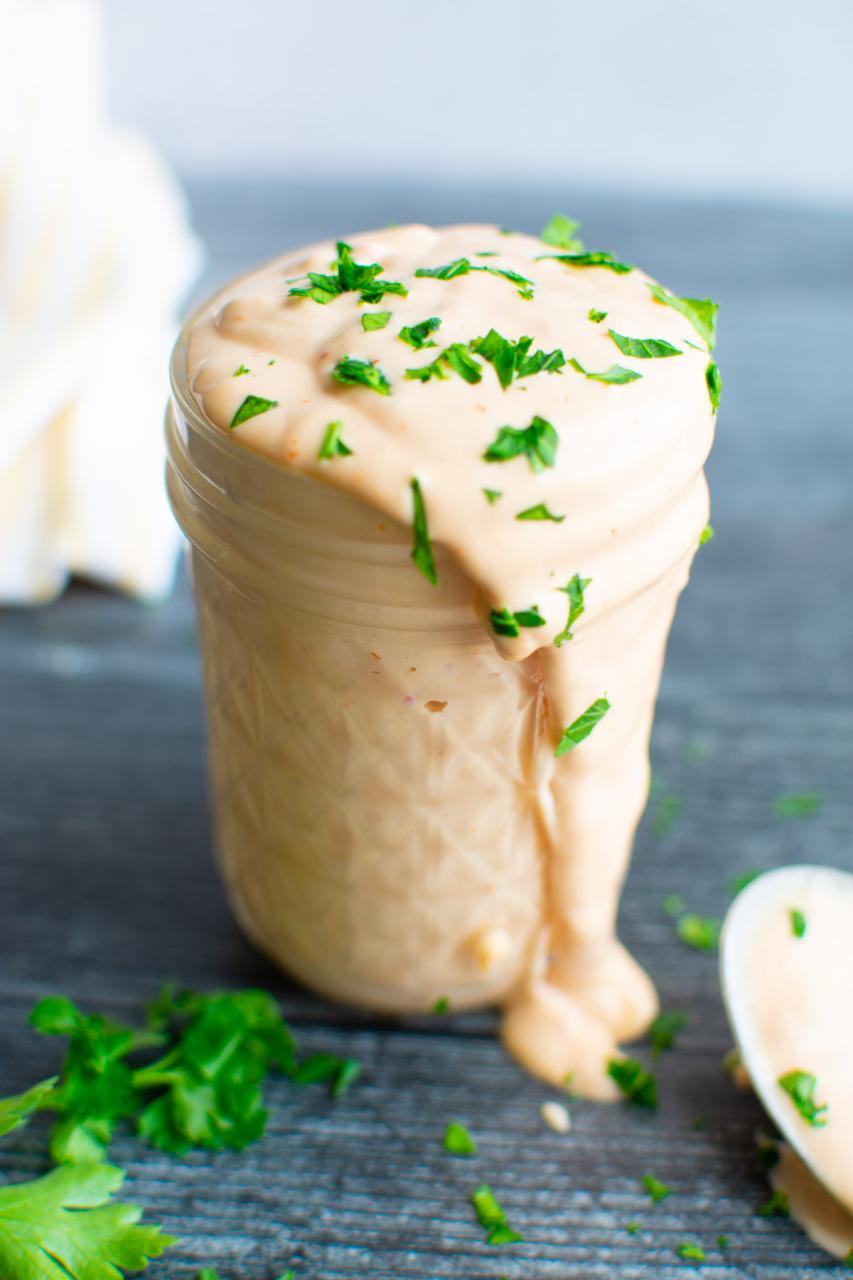Thousand Island dressing is a condiment that typically blends mayonnaise, ketchup or tomato paste, and finely chopped ingredients like pickles, onions, bell peppers, and sometimes olives. It gets its name from the Thousand Islands region located along the upper St. Lawrence River, between the United States and Canada, where it is said to have been popularized. Traditionally, the dressing is used on salads, as well as a spread on sandwiches or as a dip.
The plant-based version of Thousand Island dressing caters to those who adhere to a vegan diet, have egg allergies, or are otherwise looking to reduce their consumption of animal products. In creating plant-based Thousand Island dressing, the mayonnaise base—originally made with eggs—is replaced with a vegan alternative. Vegan mayonnaise is usually made from modified plant proteins such as soy or pea, or emulsified oils like olive, canola, or avocado, which are blended with vinegar or lemon juice and, often, a small amount of sweetener to mimic the texture and taste of traditional mayonnaise.
The rest of the ingredients in plant-based Thousand Island dressing generally remain unchanged. The ketchup or tomato paste, relish or pickles, and the finely chopped vegetables are all inherently plant-based. However, care is taken to ensure that these ingredients are also prepared without animal byproducts – for example, confirming that the sugar used in ketchup is not processed with bone char.
This plant-based dressing can be enjoyed in the same culinary applications as the original: as a refreshing and tangy addition to salads, a flavor-packed spread for sandwiches, or a creamy dipping sauce.
Pant-based Thousand Island dressing recipe


Pant-based Thousand Island dressing
Equipment
- 1 bowl of a blender
- 1 container
Ingredients
- 1/2 cup raw cashews soak the cashew for 30 minutes to 1 hour in hot water,drain
- 1/2 cup water
- 1 tbsp fresh lemon juice
- 6 tbsp ketchup
- 1-2 tbsp raw finely diced white onion
- 1/4 tsp dried mustard
- 2 tbsp sweet pickle relish reserve 1 tbsp to stir in after blending
- 1/4 tsp fine salt
- 1/4 tsp regular paprika
Instructions
- Combine all the ingredients together in a bowl of a blender or mini food processor except the reserved 1 tbsp of the sweet pickle relish and blend until smooth and creamy. Scrape down the sides of the blender, taste and make the necessary adjustment as needed.
- Transfer to a container and stir in the reserved pickle relish and stir until well mixed.
- Keep in the fridge to chill before serving. Serve dressing over salad, veggies or as you want.
- The leftover can be kept in the fridge and try to use within a week.
Cooking Tips about Pant-based Thousand Island dressing

- Vegan Mayo Base: Start with a high-quality vegan mayonnaise as your base. This can be store-bought or homemade using blended silken tofu, soy milk, or aquafaba as emulsifiers along with oil and an acid like vinegar or lemon juice.
- Customize Finely Chopped Ingredients: Keep in mind the classic flavor profile which includes pickle relish or finely diced pickles, onions, and often bell peppers. Ensure that any store-bought relishes or ketchups are vegan (without gelatin or other animal products).
- Balance the Sweetness: Traditional Thousand Island dressing often includes a sweet component. Use vegan-friendly sweeteners like agave nectar or maple syrup instead of honey if needed, or check for bone char-free sugar.
- Add Creaminess with Plant-based Ingredients: To enhance the creaminess, consider blending in soaked cashews or adding a bit of unsweetened vegan yogurt for texture.
- Seasonings and Spices: Season your dressing with salt, pepper, and paprika for a bit of smokiness. Garlic powder and a small amount of mustard can add depth to the dressing’s flavor.
- Adjust Consistency: If your dressing is too thick, thin it out with a bit of almond, soy, or oat milk. Conversely, if it is too thin, blend in more vegan mayo or plant-based yogurt until you reach the desired consistency.
- Taste and Tweak: Make sure to taste your dressing and adjust the seasonings and ingredients to your liking. A well-balanced Thousand Island dressing should be tangy, sweet, and savory, all at once.
- Refrigerate Before Use: Letting the dressing sit in the refrigerator for an hour or so before serving allows the flavors to meld together and intensify.
- Storage: Store your plant-based Thousand Island dressing in an airtight container in the fridge. It typically keeps well for several days.
- Allergy-Friendly Options: For those with nut allergies, ensure the plant-based dressing is free from almond or cashew ingredients by using alternative bases or thickeners.
Serving suggestions about Pant-based Thousand Island dressing

- Salad Dressing: Drizzle it over your favorite green salads for a tangy twist. It works exceptionally well with crisp lettuce like iceberg or romaine, adding flavor to every bite.
- Sandwich Spread: Spread a generous layer on your sandwiches or wraps in place of mayonnaise or other traditional spreads. It pairs wonderfully with veggie burgers, faux-meat deli slices, or even classic tomato and avocado sandwiches.
- Dip: Use it as a dipping sauce for an array of finger foods such as vegetable sticks, French fries, faux-chicken nuggets, or vegan mozzarella sticks.
- Burger Sauce: Slather it onto any kind of veggie burger for that classic American diner flavor—it complements the patty, lettuce, and tomatoes beautifully.
- Taco Dressing: Give your tacos a creamy topping with a dollop of this dressing. Its tangy taste balances the spices typically used in taco fillings.
- Bowl Ingredient: Spoon it into grain bowls or Buddha bowls for extra zest. The dressing can mix nicely with quinoa, brown rice, legumes, and a variety of steamed or raw vegetables.
- Reuben Sandwich: Make a plant-based Reuben sandwich by using this thousand island dressing with sauerkraut, vegan cheese, and seitan, tempeh, or a plant-based corned beef alternative.
Top 5 FAQs about Pant-based Thousand Island dressing

- What makes a Thousand Island dressing “plant-based”? Plant-based Thousand Island dressing is made without any animal-derived ingredients, specifically substituting traditional mayonnaise (which contains eggs) with a vegan mayonnaise substitute, which could be based on soy, peas, aquafaba, or other plant proteins.
- Can you taste the difference between regular and plant-based Thousand Island dressing? The taste of plant-based Thousand Island dressing can be very similar to the traditional version, especially when high-quality ingredients are used. The goal is to replicate the creamy texture and tangy flavor profile, which can often be achieved to the point where the difference is minimal or unnoticeable.
- Is plant-based Thousand Island dressing healthier than the traditional version? While plant-based Thousand Island dressing avoids egg-based mayonnaise, which can reduce cholesterol content, it’s important to note that the overall healthfulness depends on the rest of the ingredients as well. It’s best to look at the product’s nutritional information for an accurate comparison.
- How can I make my own plant-based Thousand Island dressing? To make your own, start with vegan mayonnaise as the base, then add ketchup, finely chopped pickles, onions, bell peppers, and a sweetener if desired. Adjust seasonings like salt, pepper, and sometimes paprika according to your tastes. Let it refrigerate to meld the flavors together.
- Where can you use plant-based Thousand Island dressing? Similar to the traditional dressing, the plant-based version is great on salads, as a spread for sandwiches like veggie burgers and Reubens, as a dip for fries or veggies sticks, or as a special sauce on various dishes.
Thousand Island dressing, a popular salad dressing and condiment, traditionally consists of a mayonnaise base with ingredients such as olive oil, lemon juice, orange juice, paprika, Worcestershire sauce, mustard, vinegar, cream, chili sauce, tomato puree, ketchup or Tabasco sauce, and finely chopped ingredients like pickles, onions, bell peppers, and hard-boiled eggs. A plant-based variant of Thousand Island dressing would replace the mayonnaise, which contains eggs, with a vegan mayo substitute made from plant-derived ingredients.
Plant-based alternatives to traditional mayonnaise typically use modified food starch, pea protein, or soy protein as emulsifiers instead of egg yolks. These replacements seek to mimic the texture and mouthfeel of the traditional product. Olive oil or other vegetable oils are generally already plant-based, which means the main modification in a plant-based Thousand Island dressing involves ensuring that all the binding and creamy components come from non-animal sources.
While some nuances of the flavor profile may change slightly due to the substitution of ingredients, a well-formulated plant-based Thousand Island dressing can be very similar in taste and appearance to its traditional counterpart. This makes it suitable for vegetarians, vegans, and those who avoid eggs for health or ethical reasons. Additionally, for those concerned about the environmental impact of their food choices, plant-based dressings often have a lower carbon footprint compared to those made with animal-derived ingredients.
Considering ethical perspectives, offering plant-based alternatives aligns with a growing consumer demand for products that are consistent with ethical treatment of animals and environmental stewardship. It can also provide options for those with specific dietary restrictions or allergies to eggs.
For consumers seeking to try plant-based Thousand Island dressing, careful attention to the ingredient list on commercial products is advisable to ensure that it meets their dietary preferences, as some brands may vary in their formulations. Home cooks can also create their own plant-based dressing by using available vegan mayonnaise substitutes and following a traditional Thousand Island recipe for the other ingredients.
In summary, plant-based Thousand Island dressing represents an adaptation of the traditional dressing to cater to a wider audience with varied dietary needs and preferences, with a consideration for ethical consumption and environmental impact.
Leave a Reply